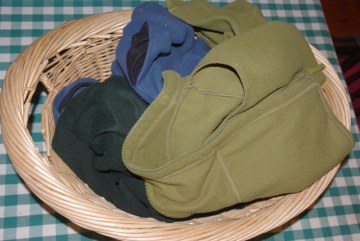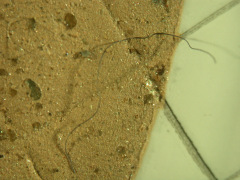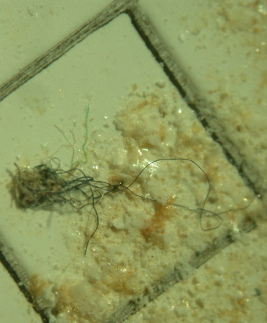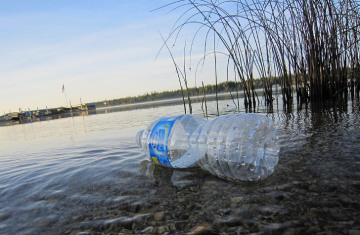Guest Contribution by Alysse Mathalon & Olivia Paitich
We want to get you thinking about microplastics. What are microplastics, you may ask? Well, as the name describes, they are tiny bits of plastic (generally up to 5 mm in size), and they happen to be everywhere – in the air, in the water, in the sand, in the seafood we eat- and, in you and me.
What got us hooked on learning about microplastics is that they are out of sight, and therefore most likely out of mind for many of us. Plastics are a serious issue. They can persist from decades to thousands of years- languishing everywhere from landfills to the ocean. They are completely unnatural in our cyclic world.
Humans produce, use and discard so much plastic that it is incomprehensible. Just imagine- every piece of plastic ever created still exists!
 To give you an idea of how many microplastics are circulating around our earth right now, let’s think about our clothing. One polyester shirt releases 1000s of tiny plastic bits with every wash. Think about how many times you wash that one shirt in a year… and that’s just one piece of one outfit!
To give you an idea of how many microplastics are circulating around our earth right now, let’s think about our clothing. One polyester shirt releases 1000s of tiny plastic bits with every wash. Think about how many times you wash that one shirt in a year… and that’s just one piece of one outfit!
Microplastics also come from degraded plastic one-time-use packaging, fishing gear, household items from razors to televisions, cars, and even from many soaps. The majority of exfoliating facial cleansers use plastic microbeads, as opposed to natural exfoliators like almond grinds or raw oats. You name it –most products that we use today are available in plastic form. As we said, it’s an incomprehensible amount.
But it gets worse. When we started researching microplastics in the ocean, we found that harmful persistent contaminants latch onto the plastics. Many of these toxins- including DDT- have carcinogenic effects. Some contaminants have been found to be up to one million times more concentrated on a microplastic compared to the surrounding seawater.
 Out in the field, we took scoops of sand from different local beaches including Rainbow Haven, as well as water from Halifax Harbour. What we found didn’t really surprise us. Our sand samples were highly concentrated with many types of microplastics: strands and spheres of all different colours and sizes. Some of the samples from Halifax Harbour were so heavily contaminated that there were literally too many microplastics to physically count.
Out in the field, we took scoops of sand from different local beaches including Rainbow Haven, as well as water from Halifax Harbour. What we found didn’t really surprise us. Our sand samples were highly concentrated with many types of microplastics: strands and spheres of all different colours and sizes. Some of the samples from Halifax Harbour were so heavily contaminated that there were literally too many microplastics to physically count.
One interesting part of our project looked at shellfish. We examined wild mussels from several Nova Scotia beaches as well as aquaculture mussels to determine if they were consuming microplastics. It turned out that both categories were contaminated. We found that the average farmed mussel contained around 200 microplastics. We were surprised at our results, which showed that the farmed mussels had double the amount of microplastics than those in the wild. We think there are more microplastics in the farmed mussels due to the “biodegradable” plastic lines that they are grown on, which constantly shed into the surrounding water that the mussels are efficiently filtering. ( Some shellfish farmers- like Indian Point Mussels- use alternatives like cotton socking.)
Once ingested by mussels, the fate of microplastics is not entirely known. Since many microplastics are quite long, they do not easily pass through the digestive system. One study found that upon ingestion, microplastics may get taken up by the circulatory system, and accumulate there. When mussels were placed in clean water, they were able to filter out many of the plastics from their circulatory systems. This can have positive implications for re-purifying mussels before they are sold.
A review of microplastics research published in 2011 shows that microplastics are being found wherever we look. Recent studies undertaken in other areas have revealed microplastics accumulating inside several fish species in the English Channel, along with the Netherland’s harbour seals.
Microplastic contamination of our seafood supply hasn’t yet been addressed by fisheries and aquaculture polices. And while some corporations (such as Unilever) have announced moves to phase out microplastic particles in their products, or to use less wasteful plastic packaging- much more needs to be done to reduce the amount of plastic we use every day. And don’t forget, even if we can stop any future plastic pollution, we will still need to develop strategies to deal with the incomprehensible amount already in our environment.
We know this may seem overwhelming – we feel overwhelmed by it everyday. We try to keep our lives as plastic-free as possible, taking special notice of the clothing we wear and the products we use. If we’re the ones putting all this plastic into the environment, it’s inevitable that we’re going to suffer the consequences of it – we’d be ignorant to think otherwise.
Our future microplastics research will be focused on trying to determine the effects that they have on fish and other animals. Questions to be answered are: How are microplastics being digested? Are they releasing the contaminants they hold into our bodies? How do we ensure our seafood is microplastic-free?
Alysse Mathalon and Olivia Paitich are currently wrapping up their final years of a Bsc with combined honours in marine biology and oceanography at Dalhousie University. They have been studying the microplastic content in the intertidal zones of three beaches along Nova Scotia’s Eastern Shore.

